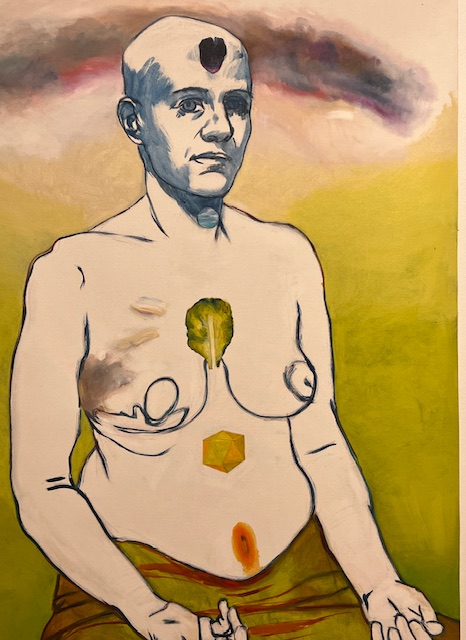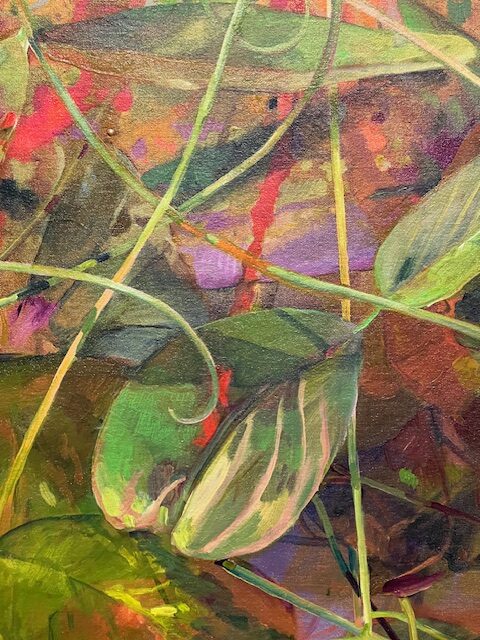“Illness is the night side of life, a more onerous citizenship. Everyone who is born holds dual citizenship, in the kingdom of the well and the kingdom of the sick. Although we all prefer to use the good passport, sooner or later each of us is obliged, as least for a spell, to identify ourselves as citizens of that other place.” Susan Sontag – Illness as Metaphor
When Margaret Lazzari received her diagnosis of breast cancer in 2003, she crossed over into the frightening and disorienting kingdom of the sick. A classically trained figurative painter and masterful draftsman, she began a body of work to help her sort her feelings -much like artists Hannah Wilke and Robert Mapplethorpe who also tracked their illnesses with powerful images. Over two years she created over 30 paintings, drawings and videos which traced her internal and external journey towards wellness and recovery with grace, honesty and bravery. These works are paradoxically both raw and highly refined, gorgeous and terrifying, portraying actual physical changes that surgery and chemotherapy created in and on her body: and tracing the unseen changes that reverberated in her soul. The exhibition Margaret Lazzari: The Cancer Series, is at USC Fisher Gallery through May 10th, 2024.
Lazzari, a very private person, noted in her catalog interview with Assistant Curator Danielle Sommer that sharing these personal images of her nude body made her uncomfortable and vulnerable, but she deemed it necessary to document the stages of her perilous journey. Four of the earliest works here are a series of self- portraits that present her before and after pictures as she loses her hair from the effects of chemotherapy. The harrowing 2003 painting “Self-Portrait in Blood Red” has her literally up to her ears in blood like a glass vessel filled with liquid.
Her epic large-scale multi-figure drawing “Being Ill as a Dance” is reminiscent of Old Masters figure studies with the bald and androgynous nude or nearly nude figures twisting and reaching out into the unknown, much like dancers about to execute a turn. But what is this dance Lazzari alludes to: the dance between health and sickness, between spirituality and science, between anxiety and equilibrium, between darkness and light? Lazzari suggests it’s a mélange of all of these wild swings of emotion that one experiences – a rough roller coaster of ups and downs, twists and turns to navigate.
Lazzari further explores this loss of stability in a remarkable animated video that brings her drawings to life, accumulating stroke by stroke as the image reappears and then disappears. The figures literally move as they sink, twist and fall through space. The accompanying soundtrack provides emotional clues to interior thoughts and feelings. The sound of ragged breaths with long pauses suddenly punctuated by loud gasps is powerful, suggesting attempts to control panic with yogic breathing and failing time and again. Images are erased, then redrawn as the bodies tumble from the upper left towards the bottom like the man who fell from earth. But then, magically, colors appear intermittingly shifting from achromatic to color. Images of the iconic Venus De Milo pop up reminding us that she too was found missing parts of her anatomy, though deemed beautiful anyway. The soundtrack turns upbeat and inventive, channeling early radio sound effects that complement the fragmentary flashing imagery. A subliminal image of the artist herself in a blue bathing suit briefly appears and the video which starts in panicky imagery ends on a hopeful note of hard- won recovery.
During her many hospital and doctor visits, Lazzari became fascinated with the color imaging of radiology tests, showing the cancer and the energy in her body which eventually led her to move from figuration to abstraction in her work. In the transitional painting “Tendrils,” 2006, acrylic on canvas, she paints vibrant, robust plants, almost looking like water lilies, with smiling faces, barely visible towards the bottom, maybe reflections in water or ghost-like images shining through the water. Perhaps images of the artist herself as she banishes cancer from her body and celebrates.
Lazzari wrote in the catalog “I want these paintings to speak to a broad audience to address whatever fear and sickness they may have… Whatever you are feeling, may it always include hope.” The artist herself has gone from the kingdom of the sick to the kingdom of the well and expertly documented the perilous but ultimately rewarding journey with her sumptuous and thoughtful paintings, drawings and brave videos. This exhibit and the journey it chronicles is a rich gift to the viewer from the ever generous and talented Margaret Lazzari.
Nancy Kay Turner; Photos by Nancy Kay Turner












































